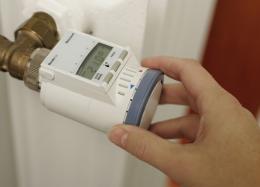Search
Login
Recommended
What is a thermostat for a heating battery, how to choose the right one, how to install, useful tips
The increase in fuel cost, the need for saving resources and the desire to use them rationally led to the thought of the need to create heating thermostats - special units capable of controlling the temperature of the medium inside the heating system. You can meet thermostatic devices of different types of work, they are separated according to the principle of transmitting an internal signal, which can be obtained from: air inside the building, from the environment surrounding the structure, directly from the coolant itself.
Content
- Different types of thermostats for heating systems video video
- Types of temperature regulators for heating batteries according to design features
- How to install the thermostat on the battery video
- Regulators for installation in two- and single-pipe systems
- Functional Features
- How does the battery thermostat work?
Different types of thermostats for heating systems

Of course, the latter option is far from perfect and today it is considered not particularly effective - it can only respond to the temperature indicators of the carrier itself, in which case it is difficult to talk about optimizing the operation of the heating system. Devices of this type, overhead or submersible, provide a certain level of economy; they are widely represented on the market and are in demand due to their low cost.
A more progressive phenomenon is the installation of temperature controllers on radiators, the principle of operation of which is based on obtaining data on temperature indicators in the building. The installation of such a device is carried out directly in a heated room, the optimization of the heating system consists in the fact that when the set temperature is reached, the system is activated, by means of a cable it transmits a signal to the boiler, thereby causing it to turn on. This option of regulating the operation of heating systems is quite effective and provides good savings.
The most modern version is the option of installing a sensor that responds to changes in temperature outside the house. The signal received from it allows temperature correction in the building in accordance with changes in weather conditions. A quick response to changes in ambient temperature allows you to prevent the very possibility of lowering the temperature inside the room. This option provides significant fuel savings, and hence the cost.
To the question of whether a temperature regulator is needed for the battery, experts answer that the integrated use of all three types of temperature regulators can be considered an ideal option - this way the consumer can get complete control over the operation of the heating system.
Types of temperature regulators for heating batteries according to design features

Devices created by the principle of direct adjustment are among the most simple by the principle of operation. The temperature regulator for the heating battery, the price of which is affordable for each family, is installed directly on the pipe designed to supply the coolant. In response to the temperature of the liquid, it, with the help of an adjustable valve, reduces or enlarges the hole, thereby regulating the volume of water entering the radiators.

Today on sale you can find devices with different design complexity:
- requiring manual adjustment, not equipped with a thermostatic head,
- having an integrated temperature sensor, equipped with a thermostatic head,
- equipped with a thermostatic head and an external temperature sensor.
The main similarity in their device is the presence of a thermostatic valve, the difference is in the equipment with a thermostatic head.
with manual adjustment
If the thermostat involves manual adjustment, then its design involves controlling the flow of coolant using a rotary head with a scale applied to its surface. It has 6 positions, with a zero valve completely covers the pipe opening, it is possible to carry out repair or maintenance of the radiator without completely draining the fluid from the heating system.
The following divisions on the scale mean a gradual increase in the amount of liquid passed through the valve of the thermostat; they correspond to temperature indicators from plus fourteen to twenty eight degrees. The position of the head should correspond to the temperature that is desirable to obtain indoors. Even at first glance it is easy to evaluate the operation of such a device as ineffective.
with automatic adjustment

Devices of this type are more advanced and equipped with a bellows and a thermostatic head. Their main advantage can be considered complete independence from external power sources - you do not need electricity to operate the valve control mechanism - the energy of the incoming sensitive thermostatic element is enough for it.
The principle of operation of the device uses the tendency of gases and liquids to expand when heated inside an enclosed space. When exposed to high temperature transferred from the coolant, gas or liquid filling the internal cavity of the sensor exerts pressure on the bellows. It will, in turn, change its size and move the stem controlling the shutter of the control valve. In the end, we get a decrease in the flow rate of the coolant.
How to install the thermostat on the battery

The installation of the temperature control device is carried out directly on the radiator pipe. Since a sensor integrated in the housing is integrated in some models, when equipping the radiator with decorative fencing or protective structures, it should be possible to move it outside the fencing, otherwise there is a possibility of overheating of the device, the temperature reflected by it will not correspond to that which the environment actually has.
A more rational option is to use a remote sensor equipped with a connecting capillary. In case of its use, the temperature controller is installed inside the fence, only the sensor is mounted outside.
The installation of a thermostat with an integrated sensor is carried out in a horizontal position, otherwise it will be affected by the temperature of the air flow rising from the hot pipe.
Regulators designed for use in single pipe and double pipe systems
Since a single-pipe or two-pipe version can be used when installing heating systems for private houses, thermostats designed for installation in each of them have some differences. Since large pressure drops are observed in a two-pipe system, devices designed for installation in them have several times greater hydraulic resistance than in units designed for single-pipe systems, i.e. their cross section is much smaller.
Functional Features

Thermostatic devices are also divided into functional capabilities:
- without preliminary adjustment of hydraulic resistance
- with the ability to make this setting.
If presetting is provided, then the system is more economical, because it becomes possible to compensate for the individual heat loss of a given room, determined in advance and taken into account during setup. Overheating of the room in this case is completely eliminated.
How does the battery thermostat work?
If the device is equipped with a valve with a pneumatic or electric actuator, then it becomes quite possible to implement complex algorithms for the functioning of the system:
- temperature control of the environment indoors and outdoors,
- day-night mode
- remote control used in smart home systems
- media temperature control.
It should not be forgotten that a prerequisite for the installation of a thermostat is to equip the radiator with a bypass, which allows you to dump excess coolant while reducing the intensity of the flow of water through the radiator.
In risers, it is recommended that automatic bypass valves be installed to compensate for the differential pressure resulting from a decrease in the total flow of fluid through the radiators. Such a situation can occur with an unexpected increase in temperature in the street by several degrees.

By installing ball valves on the way the water flows from the riser to the temperature control unit, we will be able to more easily maintain the temperature controller.






